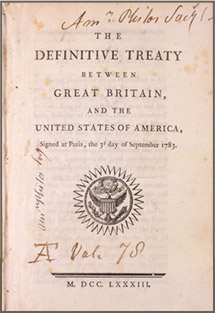 |
His Brittanic Majesty acknowledges the said United States...to be free sovereign and independent. —Treaty of Paris, September 3, 1783 |
| |
|
|
|
Map United States of America, 1783 |
Although the Revolutionary War ended with the American victory at Yorktown in the fall of 1781, the terms of peace between Britain and the United States were not formalized until September 3, 1783, when the Treaty of Paris was signed. In the two years between the end of hostilities and the signing of the Treaty, the American negotiators—Benjamin Franklin, John Adams, and John Jay—worked with their British, French, and Spanish counterparts to shape a treaty that guaranteed American sovereignty. The Treaty gave formal recognition to the United States, established its national boundaries, and provided for the evacuation of British troops. |
|
|
 |
|
Treaty between Great Britain and the United States of America, 1738 |

